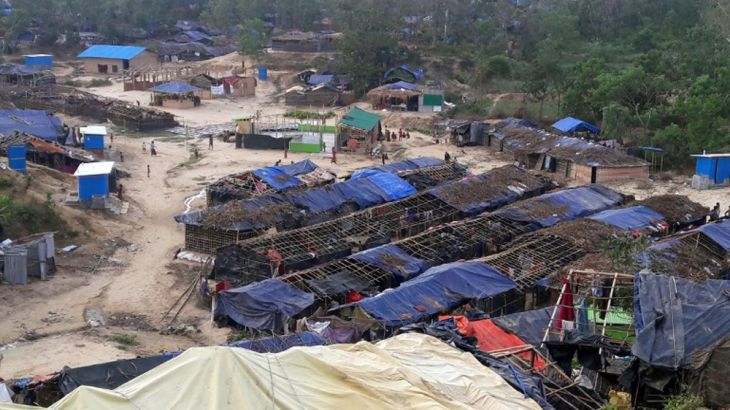Rohingya camps in Bangladesh destroyed by Cyclone Mora
Tropical storm leaves Bangladesh flooded and thousands of Rohingya refugees ‘without a roof’.

At least seven people have died and 50 others injured by Cyclone Mora that has also left thousands of Rohingya refugees in Bangladesh waiting for help after a night in the rain.
Bangladesh’s border region, home to around 12,000 Rohingya refugees that fled Myanmar, faced the brunt of the storm. It struck the island of Saint Martin and Teknaf in the coastal district of Cox’s Bazar, where officials said some 200,000 people were evacuated to shelters.
Keep reading
list of 4 itemsPhotos: Dubai reels from flood chaos as record rains lash UAE
Dubai submerged in floods as UAE gets over a year’s worth of rain in hours
Heavy rains kill 18 in Oman as flash floods lash UAE
In Chittagong district, about 150,000 people were evacuated.
Shamsul Alam, a Rohingya community leader, told Reuters news agency the damage in the camps was severe with almost all 10,000 thatched huts in the Balukhali and Kutupalong camps destroyed.
“Most of the temporary houses in the camps have been flattened,” Alam said.
The Bangladesh government estimates there are more than 300,000 Rohingya in the country. The Rohingya are a Muslim minority shunned by Myanmar’s Buddhist majority.
“We heard that a cyclone was coming. But there’s no place we can go,” 27-year-old Hamida Begum, who said she fled to Bangladesh three months ago after her husband disappeared, told Reuters on Wednesday.
![Rohingya refugees face increased risk of disease due to lack of sanitation facilities [AFP]](/wp-content/uploads/2017/05/927881de006346fb874160b9e2031a8d_18.jpeg)
“I hate being a Rohingya. We are being tortured in Myanmar. Now in Bangladesh, we have no rights. Nothing. After this cyclone, we don’t have a roof. We are living under the sky. We have no future.”
Authorities had evacuated more than 400,000 people from the low-lying border districts before the storm. However, most of the Rohingya refugees remained in their makeshift shelters when the storm struck.
“There’s no roof. We are just drinking water. The little food we had in our home was all damaged after the cyclone,” said Setara Begum, a mother of two, including a five-month old.
“My children are crying for food. I am helpless. I have no money. There’s no hope. I don’t know how I will raise my children.”
|
|
Beyond the camps, officials were also assessing the damage elsewhere. The chief administrator said 17,500 houses had been destroyed and 35,000 partially damaged in the district.
“After the storm, there’s an acute crisis of food, shelter, health services, water and sanitation facilities in the makeshift settlements,” said Sanjukta Sahany, local head of the International Organization for Migration which coordinates relief in some of the camps.
There were also pockets of damage in the broader community, but no reports of casualties, the UN Office for the Coordination of Humanitarian Affairs said.
Omar Farukh, a community leader in Kutupalong camp – one of several camps for Rohingya in Cox’s Bazar – described the misery of those left behind.
“We have passed a difficult time. We had no tin or plastic sheets above our heads, and almost all of us passed the night in the rain,” Farukh told Reuters by telephone.
“We tried to save our belongings, whatever we have, with pieces of plastic sheet,” he said before adding agency officials visited the Kutupalong camp to see what was needed.
Al Jazeera’s Tanvir Chowdhury, reporting from Kutupalong camp, said authorities and NGOs were not present in the camp and refugees had to repair the damage themselves.
“They are left on their own,” he said.
![Path of Cyclone Mora through Rohingya refugee camps [AFP]](/wp-content/uploads/2017/05/109cf9d2121d412ba9078aa11ef7624b_6.jpeg)